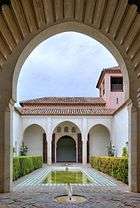Alcazaba of Málaga
| Alcazaba of Málaga | |
|---|---|
| Alcazaba de Málaga | |
| Málaga, Spain | |
|
The Alcazaba of Málaga from the sea. | |
| Coordinates | 36°43′17″N 4°24′56″W / 36.72139°N 4.41556°WCoordinates: 36°43′17″N 4°24′56″W / 36.72139°N 4.41556°W |
| Type | Palatial fortress |
| Site information | |
| Open to the public | Yes |
| Condition | Well-preserved |
| Site history | |
| Built | 10th century- 15th century |
| Built by | Hammudids |
The Alcazaba is a palatial fortification in Málaga, Spain. It was built by the Hammudid dynasty in the early 11th century.[1]
This is the best-preserved alcazaba (from the Arabic al-qasbah, قصبة, meaning "citadel") in Spain. Adjacent to the entrance of the Alcazaba are remnants of a Roman theatre dating to the 1st century BC, which are undergoing restoration. Some of the Roman-era materials were reused in the Moorish construction of the Alcazaba.
Ferdinand and Isabella captured Málaga from the Moors after the Siege of Málaga (1487), one of the longest sieges in the Reconquista, and raised their standard at the "Torre del Homenaje" in the inner citadel.
According to architect restorer, Leopoldo Torres Balbás, the Alcazaba of Málaga is the prototype of military architecture in the Taifa period, with its double walls and massive entry fortifications. Its only parallel is the castle of Krak des Chevaliers in Syria.[2]
Layout

The Alcazaba of Málaga is built on a hill in the centre of the city, overlooking the port, and comprises two walled enclosures. It was formerly connected to the city ramparts which formed a third defensive wall but only two inner walls remain. The first, built around the topography of the hill, completely encloses the second inner area and is dotted with defensive towers.
Outer citadel

The outer citadel entrance is through a gateway called "Puerta de la Bóveda" (Vault Gate), but nowadays it can also be accessed by an elevator. The entrance gate doubles back on itself, a design intended to make progress difficult for attacking forces.
The pathway winds up through gardens, with a number of elaborate fountains, passing the gateways of Puerta de las Columnas (Gate of the Columns), which reuses materials from the Roman ruins, and renamed Torre del Cristo (Tower of Christ) which turns at right angles to again impede the progress of attackers, The "Torre del Cristo" once served as a chapel.
Inner citadel
The inner enclosure can only be accessed through the Puerta de los Cuartos de Granada (Gate of the Granada Quarters) which acts as the defence for the western side of the palace. On the eastern side is the Torre del Homenaje (Tower of Tribute) which is in a semi-ruinous state.
Inside the second wall is the Palace and some other dwellings which were built on three consecutive Andalusian patios during the 11th, 13th and 14th centuries. They include the Cuartos de Granada (Quarters of Granada) which served as the home of the kings and governors.
See also
| Wikimedia Commons has media related to Alcazaba of Málaga. |
References
- "Alcazaba" (in Spanish). Ayuntamiento de Málaga. Retrieved 14 December 2006.
- "Alcazaba". Área de Turismo, Ayuntamiento de Málaga. Retrieved 5 September 2008.